The World Steel Association has issued a new short-range forecast of global steel demand, predicting the 2017 demand at 1.62 billion metric tons, and 2018 demand at 1.65 billion metric tons. For 2016, total output for raw steel production was 1.628 billion metric tons, and for the current year the World Steel Assn.’s latest (January-August) total has output running 4.8% ahead of the comparable year-ago total.
World Steel issues a semi-annual short-range outlook for steel demand, identifying trends in demand and market forces, globally and regionally. The studies are based on production of carbon raw steel (the product of basic oxygen and electric arc furnaces) in 67 countries. Stainless and specialty steel represent a separate market for output and demand.
The current year has demonstrated some recovery of demand following several years of weak-to-flat demand. However, in the April 2017 forecast, World Steel cited a long list of structural, political, and market-based factors clouding the outlook for steel demand increases.
Now, the forecast has become clearer, and more positive. T.V. Narendran, chairman of the World Steel Economics Committee, stated: “Progress in the global steel market this year to-date has been encouraging. We have seen the cyclical upturn broadening and firming throughout the year, leading to better than expected performances for both developed and developing economies, although the MENA region and Turkey have been an exception.”
Narendran continued: “The risks to the global economy that we referred to in our April 2017 outlook, such as rising populism/protectionism, U.S. policy shifts, EU election uncertainties, and China deceleration, although remaining, have to some extent abated.”
China represents a particular center of concern for the global steel industry, as it represents more than half of the installed capacity worldwide. China also has been a major exporter of semi-finished steel to other regions, expanding the effects of its capacity surplus.
In recent years, the Chinese industry has been subjected to policies of capacity modernization and aggressive consolidation. In addition, China’s exporting potential is being undercut by tariffs on imports to the U.S. and similar protectionist policies in other regions.
Narendran noted that cuts to outdated capacity in China have reached a level that means domestic demand is now satisfied by mainstream steelmakers. China’s steel demand is expected to increase by 3% in 2017, an upward revision over the previous forecast, boosted by the progress in closing small-volume and outdated steelmaking capacity.
The outlook is flat for China’s steel demand in 2018, however, as the central government resumes and strengthens its efforts to rebalance the economy to support domestic demand, and to adopt more effective standards for environmental protection.
For the developed economies (North America, the EU, Japan, South Korea), the steel-demand recovery has achieved stability. World Steel noted that the U.S. economy “continues to exhibit robust fundamentals supported by strong consumer spending and rising business confidence,”; and that the EU economic recovery is broadening.
“Japanese steel demand is showing better than expected performance benefitting from the government stimulus package, (and) improving exports," according to the forecast. South Korea’s steel demand is suffering from high consumer debts, weakening construction, and a depressed shipbuilding sector, as well as escalated tension over the North Korean nuclear weapons threat.
In these developed economies, there are positive outlooks for construction and machinery manufacturing sectors, while automotive steel demand is seen as “moderate”. In these countries, steel demand is expected to increase by 2.3% in 2017 and 0.9% in 2018.
Demand in developing countries (including Egypt, Brazil, Argentina, Mexico and India) is benefitting from a strengthening global economy, according to the World Steel report.
“This leads us to conclude that we now see the best balance of risks since the 2008 economic crisis,” Narendran commented. “However, escalating geopolitical tension in the Korean peninsula, China’s debt problem and rising protectionism in many locations continue to remain risk factors.”









